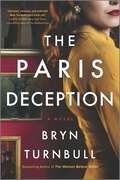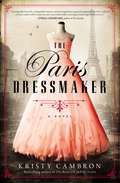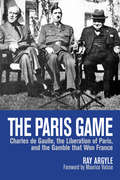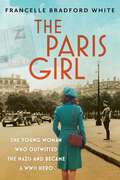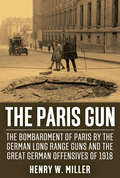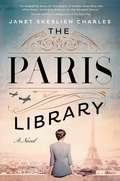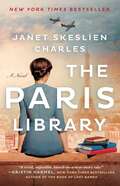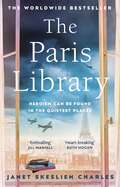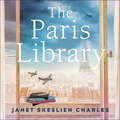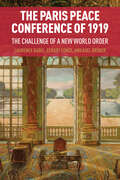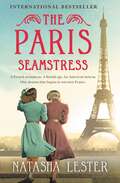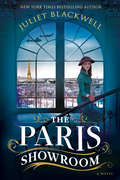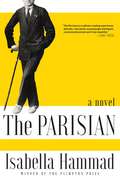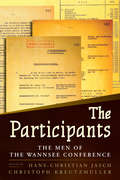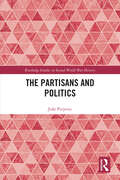- Table View
- List View
The Paris Deception: A Novel
by Bryn Turnbull&“Unforgettable . . . a powerful, page-turning tale of two extraordinary heroines who risk their lives rescuing stolen masterpieces during the Nazi occupation of Paris. A stunning read!&” —Chanel Cleeton, New York Times and USA Today bestselling author of Our Last Days in BarcelonaFrom internationally bestselling author Bryn Turnbull comes a breathtaking novel about art theft and forgery in Nazi-occupied Paris, and two brave women who risk their lives rescuing looted masterpieces from Nazi destruction.Sophie Dix fled Stuttgart with her brother as the Nazi regime gained power in Germany. Now, with her brother gone and her adopted home city of Paris conquered by the Reich, Sophie reluctantly accepts a position restoring damaged art at the Jeu de Paume museum under the supervision of the ERR—a German art commission using the museum as a repository for art they&’ve looted from Jewish families. Fabienne Brandt was a rising star in the Parisian bohemian arts movement until the Nazis put a stop to so-called &“degenerate&” modern art. Still mourning the loss of her firebrand husband, she&’s resolved to muddle her way through the occupation in whatever way she can—until her estranged sister-in-law, Sophie, arrives at her door with a stolen painting in hand.Soon the two women embark upon a plan to save Paris&’s &“degenerates,&” working beneath the noses of Germany&’s top art connoisseurs to replace the paintings in the Jeu de Paume with skillful forgeries—but how long can Sophie and Fabienne sustain their masterful illusion?
The Paris Deception: A breathtaking novel of love and courage set in wartime Paris, new for summer 2023
by Bryn TurnbullA captivating novel of wartime Paris and the women who risked everything to protect priceless treasures for their country. A beautiful story of love and courage, from the internationally bestselling author of The Woman Before Wallis, perfect for fans of Natasha Lester and Rachel Hore.EVERY CANVAS HOLDS A SECRET...PARIS, 1940.Three years ago, talented art restorer Sophie fled to Paris to escape the horrors of the Nazi regime. But now, with her beloved adoptive city under occupation, Sophie is forced to work at the renowned Jeu de Paume, restoring the art ruthlessly stolen from Jewish families.Fabienne was a rising star of the glamorous Parisian art scene, until the Nazis put a stop to her craft. Mourning the loss of her husband, she's a shadow of her former self - until her estranged sister-in-law Sophie arrives at her door with a stolen painting in hand. The two women embark on a treacherous plan: to save stolen artwork by replacing it with skilful forgeries, right under the watchful eyes of the Nazis. But just how long can they sustain their masterful illusion?YOUR FAVOURITE AUTHORS LOVE THE PARIS DECEPTION:'Deceives, intrigues, and enthrals' - Kate Quinn, bestselling author of The Rose Code'Gripping, dramatic and packed with fascinating detail . . .' - Jill Mansell, bestselling author of Should I Tell You?'Bryn Turnbull is a natural storyteller and her prose sparkles with all the fizz of vintage champagne. A tour de force' - Gill Paul, bestselling author of The Secret Wife'The Paris Deception is an engrossing tale filled with art, intrigue, and champagne.' - Kaia Alderson, author of Sisters in Arms'The Paris Deception is a moving and intimate look at two sisters-in-law whose friendship has fractured . . . Another thought-provoking, impressively researched and richly realized work from one of Canada's best historical fiction authors' - Natalie Jenner, USA Today bestselling author of The Jane Austen Society 'Had me gripped from beginning to end' - Sarah Steele, author of The Schoolteacher of Saint-Michel(P) 2023 HarperCollins Publishers
The Paris Deception: A breathtaking novel of love and courage set in wartime Paris, new for summer 2023
by Bryn Turnbull'GRIPPING' JILL MANSELL'TENSE AND THRILLING' NATASHA LESTER'INTRIGUES AND ENTHRALS' KATE QUINN'A TOUR DE FORCE' GILL PAULEVERY CANVAS HOLDS A SECRET . . .PARIS, 1940.Three years ago, talented art restorer Sophie fled to Paris to escape the horrors of the Nazi regime. But now, with her beloved adoptive city under occupation, Sophie is forced to work at the renowned Jeu de Paume, restoring the art ruthlessly stolen from Jewish families.Fabienne was a rising star of the glamorous Parisian art scene, until the Nazis put a stop to her craft. Mourning the loss of her husband, she's a shadow of her former self - until her estranged sister-in-law Sophie arrives at her door with a stolen painting in hand. The two women embark on a treacherous plan: to save stolen artwork by replacing it with skilful forgeries, right under the watchful eyes of the Nazis. But just how long can they sustain their masterful illusion?__________________________________________________READERS LOVE THE PARIS DECEPTION:'Anyone who likes historical fiction with a hint of danger will enjoy this' ⭐ ⭐ ⭐ ⭐ ⭐ Real reader review'This novel will keep the reader on the edge of their seat. If more than five stars were an option, this book would earn them' ⭐ ⭐ ⭐ ⭐ ⭐ Real reader review'Totally absorbing and I had to finish the novel once I had stared . . . a real page turner' ⭐ ⭐ ⭐ ⭐ ⭐ Real reader review'Clear your table, historical fiction lovers! This one deserves that coveted space' ⭐ ⭐ ⭐ ⭐ ⭐ Real reader review'Stunning and compelling' ⭐ ⭐ ⭐ ⭐ ⭐ Real reader review'The Paris Deception is so difficult to put down' ⭐ ⭐ ⭐ ⭐ ⭐ Real reader review
The Paris Dressmaker
by Kristy CambronBased on true accounts of how Parisiennes resisted the Nazi occupation in World War II—from fashion houses to the city streets—comes a story of two courageous women who risked everything to fight an evil they couldn&’t abide.Paris, 1939. Maison Chanel has closed, thrusting haute couture dressmaker Lila de Laurent out of the world of high fashion as Nazi soldiers invade the streets and the City of Lights slips into darkness. Lila&’s life is now a series of rations, brutal restrictions, and carefully controlled propaganda while Paris is cut off from the rest of the world. Yet in hidden corners of the city, the faithful pledge to resist. Lila is drawn to La Resistance and is soon using her skills as a dressmaker to infiltrate the Nazi elite. She takes their measurements and designs masterpieces, all while collecting secrets in the glamorous Hôtel Ritz—the heart of the Nazis&’ Parisian headquarters. But when dashing René Touliard suddenly reenters her world, Lila finds her heart tangled between determination to help save his Jewish family and bolstering the fight for liberation.Paris, 1943. Sandrine Paquet&’s job is to catalog the priceless works of art bound for the Führer&’s Berlin, masterpieces stolen from prominent Jewish families. But behind closed doors, she secretly forages for information from the underground resistance. Beneath her compliant façade lies a woman bent on uncovering the fate of her missing husband . . . but at what cost? As Hitler&’s regime crumbles, Sandrine is drawn in deeper when she uncrates an exquisite blush Chanel gown concealing a cryptic message that may reveal the fate of a dressmaker who vanished from within the fashion elite.Told across the span of the Nazi occupation, The Paris Dressmaker highlights the brave women who used everything in their power to resist darkness and restore light to their world.Praise for The Paris Dressmaker:&“Unimaginable heartache, unforgettable romance, and cheering defiance against the oppression the Nazis inflicted on Paris; readers will be swept away into a story where battle-scarred good at last rings victory over evil.&” —J&’nell Ciesielski, author of The Socialite&“Stunning. With as much skill and care as the title&’s namesake possesses, The Paris Dressmaker weaves together the stories of two heroines who boldly defy the darkness that descends on the City of Light.&” —Jocelyn Green, Christy Award-winning author of Shadows of the White City&“A thoroughly satisfying blend of memorable characters, evocative writing, and wartime drama that seamlessly transport you to the City of Light at its most desperate hour.&” —Susan Meissner, bestselling author of The Nature of Fragile Things&“Kristy Cambron deftly weaves multiple timelines to craft a story as complex and romantic and beautiful as a couture gown. In addition, Lila and Sandrine&’s strength and courage in a troubled world inspire us to live likewise. Tres magnifique!&” —Sarah Sundin, bestselling and award-winning author of When Twilight Breaks and the Sunrise at Normandy series&“With real life historical details woven in with her fictional tale, the story popped off the page. Readers will be thinking of this book long after they've read the last word.&” —Rachel Hauck, New York Times bestselling author&“A well-researched and beautifully interwoven treatise on courage and conviction in the midst of oppression.&” —Rachel McMillan, author of The London Restoration and The Mozart CodeStand-alone WWII novelFull-length, approximately 115,000 wordsIncludes discussion questions for book clubs
The Paris Game: Charles de Gaulle, the Liberation of Paris, and the Gamble that Won France
by Ray Argyle Maurice VaïsseAt a crucial moment in the Second World War, an obscure French general reaches a fateful personal decision: to fight on alone after his government’s flight from Paris and its capitulation to Nazi Germany. Amid the ravages of a world war, three men — a general, a president, and a prime minister — are locked in a rivalry that threatens their partnership and puts the world’s most celebrated city at risk of destruction before it can be liberated. This is the setting of The Paris Game, a dramatic recounting of how an obscure French general under sentence of death by his government launches on the most enormous gamble of his life: to fight on alone after his country’s capitulation to Nazi Germany. In a game of intrigue and double-dealing, Charles de Gaulle must struggle to retain the loyalty of Winston Churchill against the unforgiving opposition of Franklin Roosevelt and the traitorous manoeuvring of a collaborationist Vichy France. How he succeeds in restoring the honour of France and securing its place as a world power is the stuff of raw history, both stirring and engrossing.
The Paris Girl: The Young Woman Who Outwitted the Nazis and Became a WWII Hero
by Francelle Bradford WhiteMovingly written by her own daughter, this captivating and intimate biography chronicles the astonishing courage Andrée Griotteray, a teenage girl in Nazi-occupied Paris who would become a hero of the French Resistance through her harrowing work as an underground intelligence courier. For readers of Three Ordinary Girls, A Woman of No Importance, Lis Parisiennes, The Girls Who Stepped Out of Line, and the many other untold stories of WWII&’s &“hidden figures.&” Andrée Griotteray was just 19 when the Germans invaded France and occupied Paris, where she worked as a clerk in the passport office. When her younger brother, Alain, created a resistance network named Orion, Andrée joined his efforts, secretly typing up and printing copies of an underground newspaper, and stealing I.D. cards which allowed scores of Jewish citizens to escape persecution. Charming and pretty, Andrée nimbly avoided the unwanted attentions of German officers, even as she secretly began working as an undercover courier. Displaying fearlessness in the face of immense pressure, she traveled throughout the county delivering vital intelligence destined for France&’s allies—until the day she was betrayed and arrested. Throughout her ordeal, Andrée stayed composed, refusing to inform on her comrades. Before she was set free, she even duped her interrogators into revealing who had betrayed Orion, and continued her underground activities until France&’s liberation. Weaving in diary entries, letters, and conversations, Andrée&’s daughter, Francelle, brings a uniquely personal slant to her mother&’s story. The Paris Girl reveals the narrow escapes and moments of terror, the daily acts of bravery and defiance, and the extraordinary courage displayed by Andrée and so many of her contemporaries, that helped turned the tide of war.
The Paris Gun
by Henry W. MillerThe Paris Gun, first published in 1930, is a detailed account of the design, construction, and operation of the several German long-range cannons used to bombard Paris in 1918. While not accurate, the guns were used to instill terror in the civilian population and over 300 of the massive shells were fired on the city between March 23 and August 9, 1918. After the war, author Henry Miller, a U.S. Army ordnance officer, interviewed German artillery officers who were directly involved in the project, providing a unique, first-hand look at these weapons. Included are 38 pages of illustrations and maps.
The Paris Housekeeper
by Renee RyanFrom the author of The Secret Society of Salzburg comes a powerful and moving story of bravery and resilience in World War II Paris and one woman who must face impossible choices to survive…Paris, 1940German tanks rumble through the streets of Paris, forcing frightened citizens to flee. But not everyone has the luxury to leave. Camille Lacroix, a chambermaid at the world-famous Hôtel Ritz, must stay to support her family back home in Brittany. Desperate to earn money, Camille also acts as a lady&’s maid for longtime guest Vivian Miller, a glamorous American widow—and a Nazi sympathizer.Despite her distrust of the woman, Camille turns to Vivian when her friend and fellow hotel maid Rachel Berman needs help getting out of Paris. It&’s then that Camille discovers that Vivian is not what she seems… The American has been using her wealth and connections to secretly obtain travel papers for Jewish refugees.While they're hiding Rachel in an underground bunker under a Nazi&’s nose, a daring escape plan is hatched. But as the net grows tighter, and the Germans more ruthless, Camille&’s courage will be tested to the extreme…&“Renee Ryan is a brilliant storyteller.&”—Madeline Martin, New York Times bestselling author of The Librarian Spy
The Paris Library: A Novel
by Janet Skeslien CharlesBased on the true World War II story of the American Library in Paris, an unforgettable novel about the power of books and the bonds of friendship—and the ordinary heroes who can be found in the most perilous times and the quietest places.Paris, 1939. Young, ambitious, and tempestuous, Odile Souchet has it all: Paul, her handsome police officer beau; Margaret, her best friend from England; Remy, her twin brother who she adores; and a dream job at the American Library in Paris, working alongside the library&’s legendary director, Dorothy Reeder. When World War II breaks out, Odile stands to lose everything she holds dear—including her beloved library. After the Nazi army marches into the City of Light and declares a war on words, Odile and her fellow librarians join the Resistance with the best weapons they have: books. Again and again, they risk their lives to help their fellow Jewish readers, but by war&’s end, Odile tastes the bitter sting of unspeakable betrayal. Montana, 1983. Odile&’s solitary existence in gossipy small-town Montana is unexpectedly interrupted by her neighbor Lily, a lonely teenager craving adventure. As Lily uncovers more about Odile&’s mysterious past, they find they share not only a love of language but also the same lethal jealousy. Odile helps Lily navigate the troubled waters of adolescence by always recommending the right book at the right time, never suspecting that Lily will be the one to help her reckon with her own terrible secret. Based on the true story of the American Library in Paris, The Paris Library is a mesmerizing and captivating novel about the people and the books that make us who we are, for good and for bad, and the courage it takes to forgive.
The Paris Library: A Novel
by Janet Skeslien CharlesAn instant New York Times, Washington Post, and USA TODAY bestseller—based on the true story of the heroic librarians at the American Library in Paris during World War II—The Paris Library is a moving and unforgettable &“ode to the importance of libraries, books, and the human connections we find within both&” (Kristin Harmel, New York Times bestselling author). Paris, 1939: Young and ambitious Odile Souchet seems to have the perfect life with her handsome police officer beau and a dream job at the American Library in Paris. When the Nazis march into the city, Odile stands to lose everything she holds dear, including her beloved library. Together with her fellow librarians, Odile joins the Resistance with the best weapons she has: books. But when the war finally ends, instead of freedom, Odile tastes the bitter sting of unspeakable betrayal. Montana, 1983: Lily is a lonely teenager looking for adventure in small-town Montana. Her interest is piqued by her solitary, elderly neighbor. As Lily uncovers more about her neighbor&’s mysterious past, she finds that they share a love of language, the same longings, and the same intense jealousy, never suspecting that a dark secret from the past connects them. &“A love letter to Paris, the power of books, and the beauty of intergenerational friendship&” (Booklist), The Paris Library shows that extraordinary heroism can sometimes be found in the quietest places.
The Paris Library: the bestselling novel of courage and betrayal in Occupied Paris
by Janet Skeslien CharlesIN THE DARKNESS OF WAR, THE LIGHT OF BOOKS - HOW LIBRARIANS DEFIED THE NAZISTHE NEW YORK TIMES BESTSELLER'A wonderful novel celebrating the power of books and libraries to change people's lives' JILL MANSELL'Heart-breaking and heart-lifting and always enchanting' RUTH HOGAN'An irresistible and utterly compelling novel that will appeal to bibliophiles and historical fiction fans alike' SUNDAY EXPRESS'I devoured The Paris Library in one hungry gulp . . . charming and moving' TATIANA DE ROSNAY'An irresistible, compelling read' FIONA DAVIS'Paris and libraries. What's not to love?!' NATASHA LESTER'Compelling' WOMAN & HOME'Delightful, richly detailed' PUBLISHER'S WEEKLYPARIS, 1939Odile Souchet is obsessed with books, and her new job at the American Library in Paris - with its thriving community of students, writers and book lovers - is a dream come true. When war is declared, the Library is determined to remain open. But then the Nazis invade Paris, and everything changes.In Occupied Paris, choices as black and white as the words on a page become a murky shade of grey - choices that will put many on the wrong side of history, and the consequences of which will echo for decades to come.'Book obsessives will adore this immersive love letter to the power of the written word.' RED MAGAZINEMONTANA, 1983Lily is a lonely teenager desperate to escape small-town Montana. She grows close to her neighbour Odile, discovering they share the same love of language, the same longings. But as Lily uncovers more about Odile's mysterious past, she discovers a dark secret, closely guarded and long hidden.Based on the true Second World War story of the heroic librarians at the American Library in Paris, this is an unforgettable novel of romance, friendship, family, and of heroism found in the quietest of places.
The Paris Library: the bestselling novel of courage and betrayal in Occupied Paris
by Janet Skeslien CharlesIN THE DARKNESS OF WAR, THE LIGHT OF BOOKS'A wonderful novel celebrating the power of books and libraries to change people's lives' Jill Mansell'A book about books, lovers and book lovers - what's not to love?' Ruth Hogan'I devoured The Paris Library in one hungry gulp . . . charming and moving' Tatiana de Rosnay'An irresistible, compelling read' Fiona Davis'Paris and libraries. What's not to love?!' Natasha Lester'Delightful, richly detailed' Publishers' WeeklyPARIS, 1939Odile Souchet is obsessed with books, and her new job at the American Library in Paris - with its thriving community of students, writers and book lovers - is a dream come true. When war is declared, the Library is determined to remain open. But then the Nazis invade Paris, and everything changes.In Occupied Paris, choices as black and white as the words on a page become a murky shade of grey - choices that will put many on the wrong side of history, and the consequences of which will echo for decades to come.MONTANA, 1983Lily is a lonely teenage desperate to escape small-town Montana. She grows close to her neighbour Odile, discovering they share the same love of language, the same longings. But as Lily uncovers more about Odile's mysterious past, she discovers a dark secret, closely guarded and long hidden.Based on the true Second World War story of the heroic librarians at the American Library in Paris, this is an unforgettable novel of romance, friendship, family, and of heroism found in the quietest of places.(P) 2020 Hodder & Stoughton Ltd
The Paris Orphan
by Natasha LesterAn American soldier and an enterprising photographer brave occupied France during World War II to help give a little girl her dream--a family--in this gripping novel from the bestselling author of The Paris Seamstress.New York City/Paris, 1942: When American model Jessica May arrives in Europe to cover the war as a photojournalist for Vogue, most of the soldiers are determined to make her life as difficult as possible. But three friendships change that. Journalist Martha Gellhorn encourages Jess to bend the rules. Captain Dan Hallworth keeps her safe in dangerous places so she can capture the stories that truly matter. And most important of all, the love of a little orphan named Victorine gives Jess strength to do the impossible. But her success will come at a price...France, 2005: Decades after World War II, D'Arcy Hallworth arrives at a beautiful chateau to curate a collection of famous wartime photos by a reclusive artist. It's the opportunity of a lifetime, but D'Arcy has no idea that this job will uncover decades of secrets that, once revealed, will change everything she thought she knew about her mother, Victorine, and alter D'Arcy's life forever.Includes a reading group guide! "An emotional and sweeping tale set against the backdrop of World War II...Rich detail, compelling characters, and an interwoven dual timeline make this an engrossing read for historical fiction fans." --Chanel Cleeton, USA Today bestselling author of Next Year in Havana"[A] splendid, breathtaking novel, full of mystery and passion...a must read!" --Jeanne Mackin, author of The Last Collection
The Paris Peace Conference of 1919: The Challenge of a New World Order
by Axel Dröber Laurence Badel, Eckart ConzeFor more than a century, the Paris Peace Conference of 1919 has remained an object of historical scrutiny. As an attempt to consolidate peace in the wake of World War I and to prevent future conflict, it was instrumental in shaping political and social dynamics both nationally and internationally. Yet, in spite of its implications for global conflict, little consideration has been given to the way the Paris Peace Conference constructed a new global order. In this illuminating and geographically wide-ranging reassessment, The Paris Peace Conference of 1919 reconsiders how this watershed event, its diplomatic negotiations and the peace treaties themselves gave rise to new dynamics of global power and politics. In doing so it highlights the way in which the forces of nationality and imperiality interacted with, and were reshaped by, the peace.
The Paris Seamstress
by Natasha LesterFor readers of Lilac Girls and The Nightingale comes an internationally bestselling World War II novel that spans generations, crosses oceans, and proves just how much two young women are willing to sacrifice for love and family.1940: As the Germans advance upon Paris, young seamstress Estella Bissette is forced to flee everything she's ever known. She's bound for New York City with her signature gold dress, a few francs, and a dream: to make her mark on the world of fashion. Present day: Fabienne Bissette journeys to the Met's annual gala for an exhibit featuring the work of her ailing grandmother - a legend of women's fashion design. But as Fabienne begins to learn more about her beloved grandmother's past, she uncovers a story of tragedy, heartbreak and family secrets that will dramatically change her own life.Publishers Weekly Most Anticipated Books of the YearIncluded in BookBub's "Best Historical Fiction Fiction Coming this Fall" "This rich, memorable novel unfolds beautifully from start to finish." --Publishers Weekly, Starred Review"Fascinating and impeccably researched." --Gill Paul, author of The Secret Wife"A fantastically engrossing story. I love it." --Kelly Rimmer, USA Today bestselling author"Gorgeously rich and romantic." --Kate Forsyth, author of Bitter Greens"Intrigue, heartbreak... I cannot tell you how much I loved this book." --Rachel Burton, author of The Things We Need to Say"If you're looking for a swoon-worthy romance, then The Paris Seamstress is for you. Natasha Lester's novel features not one but two love stories, spanning continents and centuries. ... Fans of historical romance will eat this one up."--Refinery29
The Paris Seamstress: Transporting, Twisting, the Most Heartbreaking Novel You'll Read This Year
by Natasha Lester**THE FRENCH PHOTOGRAPHER is now available in ebook**THE INTERNATIONAL BESTSELLER'This has to be the most beautiful book I've read in a very long time' *****'The best book I have read!' *****'Superbly written with characters I truly cared and worried about' *****'If you like Kate Morton or Lucinda Riley, you'll like this too' *****Crossing generations, society's boundaries and international turmoil, The Paris Seamstress is a beguiling, transporting story perfect for fans of Lucinda Riley, Kate Furnivall, Kate Morton and Penny Vincenzi.***************What must Estella sacrifice to make her mark?1940: Parisian seamstress Estella Bissette is forced to flee France as the Germans advance. She is bound for Manhattan with a few francs, one suitcase, her sewing machine and a dream: to have her own atelier.2015: Australian curator Fabienne Bissette journeys to the annual Met Gala for an exhibition of her beloved grandmother's work - one of the world's leading designers of ready-to-wear. But as Fabienne learns more about her grandmother's past, she uncovers a story of tragedy, heartbreak and secrets - and the sacrifices made for love.PRAISE FOR NATASHA LESTER...'Fascinating and impeccably researched' GILL PAUL'A fantastically engrossing story. I love it' KELLY RIMMER'A beautiful story in every way' THE LADY'Intrigue, heartbreak... I cannot tell you how much I loved this book' RACHEL BURTON'If you enjoy historical fiction (and even if you don't) you will love this book' Sally Hepworth'A gorgeously rich and romantic novel' Kate Forsyth'Stunning . . . Will have you captivated' Liz Byrski'This romance will have you enchanted' Woman's Day'Natasha Lester is our generation's Louisa May Alcott' Tess Woods'What a GEM!' Sara Foster'Natasha Lester brings bold, brave women to life' Courier Mail 'I love this book' Rachael Johns'Exquisite!' Vanessa Carnevale'Engaging' Herald Sun'An essential addition to Australian fiction' AusRomToday'Utterly compelling' Good Reading 'Emotion that will touch your heart and soul deeply' Jodi Gibson 'Fascinating, evocative and meticulously researched' Annabel Abbs'Entertaining and provocative' Perth Festival 'Lester has woven a fine, original story of everlasting quality.' BetterReading 'A captivating tale' Daily Examiner 'A delightful and multi-faceted romp through the jazz era' Natalie Salvo'Excellent historical fiction' The Book Muse 'You will love this even if you're not a regular reader of historical fiction' Jess Just Reads 'Storytelling at its finest' Great Reads & Tea Leaves
The Paris Seamstress: Transporting, Twisting, the Most Heartbreaking Novel You'll Read This Year
by Natasha Lester**THE FRENCH PHOTOGRAPHER is now available in ebook**THE INTERNATIONAL BESTSELLER'This has to be the most beautiful book I've read in a very long time' *****'The best book I have read!' *****'Superbly written with characters I truly cared and worried about' *****'If you like Kate Morton or Lucinda Riley, you'll like this too' *****Crossing generations, society's boundaries and international turmoil, The Paris Seamstress is a beguiling, transporting story perfect for fans of Lucinda Riley, Kate Furnivall, Kate Morton and Penny Vincenzi.***************What must Estella sacrifice to make her mark?1940: Parisian seamstress Estella Bissette is forced to flee France as the Germans advance. She is bound for Manhattan with a few francs, one suitcase, her sewing machine and a dream: to have her own atelier.2015: Australian curator Fabienne Bissette journeys to the annual Met Gala for an exhibition of her beloved grandmother's work - one of the world's leading designers of ready-to-wear. But as Fabienne learns more about her grandmother's past, she uncovers a story of tragedy, heartbreak and secrets - and the sacrifices made for love.PRAISE FOR NATASHA LESTER...'Fascinating and impeccably researched' GILL PAUL'A fantastically engrossing story. I love it' KELLY RIMMER'A beautiful story in every way' THE LADY'Intrigue, heartbreak... I cannot tell you how much I loved this book' RACHEL BURTON'If you enjoy historical fiction (and even if you don't) you will love this book' Sally Hepworth'A gorgeously rich and romantic novel' Kate Forsyth'Stunning . . . Will have you captivated' Liz Byrski'This romance will have you enchanted' Woman's Day'Natasha Lester is our generation's Louisa May Alcott' Tess Woods'What a GEM!' Sara Foster'Natasha Lester brings bold, brave women to life' Courier Mail 'I love this book' Rachael Johns'Exquisite!' Vanessa Carnevale'Engaging' Herald Sun'An essential addition to Australian fiction' AusRomToday'Utterly compelling' Good Reading 'Emotion that will touch your heart and soul deeply' Jodi Gibson 'Fascinating, evocative and meticulously researched' Annabel Abbs'Entertaining and provocative' Perth Festival 'Lester has woven a fine, original story of everlasting quality.' BetterReading 'A captivating tale' Daily Examiner 'A delightful and multi-faceted romp through the jazz era' Natalie Salvo'Excellent historical fiction' The Book Muse 'You will love this even if you're not a regular reader of historical fiction' Jess Just Reads 'Storytelling at its finest' Great Reads & Tea Leaves
The Paris Secret
by Natasha LesterFrom the New York Times bestselling author of The Paris Orphan comes an unforgettable historical novel about a secret collection of Dior gowns that ties back to the first female pilots of WWII and a heartbreaking story of love and sacrifice.England, 1939: The Penrose sisters couldn't be more different. Skye is a daring and brash pilot, and Liberty the one to defy her at every turn. Even if women aren't allowed in the Royal Air Force, Skye is determined to help the war effort. She's thrilled when it reunites her with her childhood soulmate, Nicholas. She's less thrilled to learn Nicholas is now engaged to an enigmatic Frenchwoman named Margaux Jourdan. Paris, 1947: Designer Christian Dior unveils his glamorous first collection to a world weary of war and grief. He names his debut fragrance Miss Dior in tribute to his beloved sister Catherine, who forged a friendship with Skye and Margaux through her work with the French Resistance.Present Day: Fashion conservator Kat Jourdan discovers a priceless collection of Dior gowns in her grandmother's vacant cottage. As she delves into the mystery of their origin, Kat begins to doubt everything she thought she knew about her beloved grandmother.
The Paris Secret: An epic and heartbreaking love story set during World War Two
by Natasha LesterA wartime legacy. A lost love. A friendship to last a lifetime . . .'A meticulously researched novel about the lengths people will go to protect one another, and a love that lasts a lifetime . . . an extraordinary book' Marie Claire A decades old secret . . .When Kat Jourdan discovers a priceless collection of Dior gowns hidden in her grandmother's remote cottage, she delves into the mystery of their origin, determined to know more about her beloved grandmother's secret past.An unspeakable betrayal . . .In England, 1939, talented pilot Skye Penrose is flying for the Royal Air Force. She soon meets a mysterious Frenchwoman named Margaux Jourdan, and with her is Catherine Dior, the sister of the renowned designer. Together, they have no idea of the danger that lies ahead . . .Three women bound forever by war.As Kat attempts to solve the mystery of the past, her grandmother's hidden life comes to light. But could it be that some secrets are best left buried?Set between Europe's war-torn past and the present day, The Paris Secret is an unforgettable story of love and sacrifice. Perfect for fans of Kate Furnivall, Lucinda Riley and Tracy Rees.PRAISE FOR NATASHA LESTER:'Divine' GILL PAUL, bestselling author of The Secret Wife'An emotional and sweeping tale' CHANEL CLEETON, bestselling author of Next Year in Havana 'A splendid, breathtaking novel, full of mystery and passion...a must read!' JEANNE MACKIN, author of The Last Collection
The Paris Secret: An epic and heartbreaking love story set during World War Two
by Natasha LesterA wartime legacy. A lost love. A friendship to last a lifetime . . .'An extraordinary book' Marie ClaireA decades old secret . . .When Kat Jourdan discovers a priceless collection of Dior gowns hidden in her grandmother's remote cottage, she delves into the mystery of their origin, determined to know more about her beloved grandmother's secret past.An unspeakable betrayal . . .In England, 1939, talented pilot Skye Penrose is flying for the Royal Air Force. She soon meets a mysterious Frenchwoman named Margaux Jourdan, and with her is Catherine Dior, the sister of the renowned designer. Together, they have no idea of the danger that lies ahead . . .Three women bound forever by war.As Kat attempts to solve the mystery of the past, her grandmother's hidden life comes to light. But could it be that some secrets are best left buried?Set between Europe's war-torn past and the present day, The Paris Secret is an unforgettable story of love and sacrifice. Perfect for fans of Kate Furnivall, Lucinda Riley and Tracy Rees.PRAISE FOR NATASHA LESTER:'Divine'GILL PAUL, bestselling author of The Secret Wife'An emotional and sweeping tale'CHANEL CLEETON, bestselling author of Next Year in Havana'A splendid, breathtaking novel, full of mystery and passion...a must read!'JEANNE MACKIN, author of The Last Collection
The Paris Showroom
by Juliet BlackwellIn Nazi-occupied Paris, a talented artisan must fight for her life by designing for her enemies. From New York Times bestselling author Juliet Blackwell comes an extraordinary story about holding on to hope when all seems lost. Capucine Benoit works alongside her father to produce fans of rare feathers, beads, and intricate pleating for the haute couture fashion houses. But after the Germans invade Paris in June 1940, Capucine and her father must focus on mere survival—until they are betrayed to the secret police and arrested for his political beliefs. When Capucine saves herself from deportation to Auschwitz by highlighting her connections to Parisian design houses, she is sent to a little-known prison camp located in the heart of Paris, within the Lévitan department store. There, hundreds of prisoners work to sort through, repair, and put on display the massive quantities of art, furniture, and household goods looted from Jewish homes and businesses. Forced to wait on German officials and their wives and mistresses, Capucine struggles to hold her tongue in order to survive, remembering happier days spent in the art salons, ateliers, and jazz clubs of Montmartre in the 1920s. Capucine&’s estranged daughter, Mathilde, remains in the care of her conservative paternal grandparents, who are prospering under the Nazi occupation. But after her mother is arrested and then a childhood friend goes missing, the usually obedient Mathilde finds herself drawn into the shadowy world of Paris&’s Résistance fighters. As her mind opens to new ways of looking at the world, Mathilde also begins to see her unconventional mother in a different light. When an old acquaintance arrives to go &“shopping&” at the Lévitan department store on the arm of a Nazi officer and secretly offers to help Capucine get in touch with Mathilde, this seeming act of kindness could have dangerous consequences.
The Parisian
by Isabella Hammad<p>Midhat Kamal navigates his way across a fractured world, from the shifting politics of the Middle East to the dinner tables of Montpellier and a newly tumultuous Paris. He discovers that everything is fragile- love turns to loss, friends become enemies, and everyone is looking for a place to belong. <p>Through Midhat's eyes we see the tangled politics and personal tragedies of a turbulent era - the Palestinian struggle for independence, the strife of the early twentieth century, and the looming shadow of the Second World War. Told in rich and sumptuous detail, The Parisian asks profound questions about cultural identity, politics, love, and how we retain our humanity in a deeply conflicted world.</p>
The Parlor Provocateur or From Salon to Soap-Box
by Kate Crane GartzKate Crane Gartz delighted in describing herself as the first ‘parlor Bolshevik.’ The daughter of Chicago industrialist and philanthropist Richard T. Crane, sister of Chicago Socialist and strike activist Frances Crane Lillie, Gartz moved from reform to revolution with the currents of the Russian Revolution and World War I. Her unique form of protest was letter-writing.
The Participants: The Men of the Wannsee Conference
by Hans-Christian Jasch Christoph KreutzmüllerOn 20 January 1942, fifteen senior German government officials attended a short meeting in Berlin to discuss the deportation and murder of the Jews of Nazi-occupied Europe. Despite lasting only a few hours, the Wannsee Conference is today understood as a signal episode in the history of the Holocaust, exemplifying the labor division and bureaucratization that made the "Final Solution" possible. Yet while the conference itself has been exhaustively researched, many of its attendees remain relatively obscure. Combining accessible prose with scholarly rigor, The Participants presents fascinating profiles of the all-too-human men who implemented some of the most inhuman acts in history.
The Partisans and Politics (Routledge Studies in Second World War History)
by Jože PirjevecThis book explores the military events and diplomatic games in the later years of the Second World War through which Josip Broz Tito's Yugoslav Partisans resistance movement gained the support of the Allies and, eventually, control over Yugoslavia itself.Based on research by the author in Yugoslav, German, British, American, Italian, and Russian archives and libraries, including the unpublished war memoirs of Josip Broz Tito, the volume follows Winston Churchill’s 1943 strategic decision to shift Allied support from Draža Mihailović's Chetniks, who sought the restoration of Peter II to the Yugoslav throne, to Tito and his Communist Party. Tito and Churchill continued to face conflict over concessions regarding the monarchy, as well as the growing influence of Joseph Stalin, who began sending the Partisans large arms supplies. Pirjevec’s narrative of these tensions sheds new light on the dynamics of the wartime events leading to the start of the Cold War and the emergence of new nationalist movements in the region in the second half of the 20th century. The book celebrates Tito and his Partisans for their fight against Nazi-fascism without, however, ignoring their atrocities.This volume will appeal to readers interested in the lesser-known chapters of the Second World War and the history of Yugoslavia.
